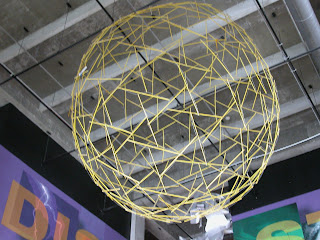 Hanging high above the center of the MOSI Grand Lobby is a very large and odd-looking sphere composed of yellow rods and wire. If you spend a few moments and really look at the sphere you will see that none of the yellow rods that compose the sphere are touching each other. This neat bit of science is known as a Tensile Integrity Sphere.
Hanging high above the center of the MOSI Grand Lobby is a very large and odd-looking sphere composed of yellow rods and wire. If you spend a few moments and really look at the sphere you will see that none of the yellow rods that compose the sphere are touching each other. This neat bit of science is known as a Tensile Integrity Sphere.How does it work?:
A tensile integrity sphere or tensegrity sphere is a structure that utilizes synergy of components in balanced compression and tension for structural support.
Compression is stress or force applied to materials resulting in their compaction. In the case of this sphere the yellow rods are under compression. Tension is a force that pulls upon an object using strings or wires and is the opposite of compression. The wires in the tensegrity sphere are in tension. Synergy is a situation where different entities or forces cooperate advantageously for a final outcome, in our case keeping the sphere round without external supports. Utilizing the forces of compression and tension in synergy this 130 pound sphere is entirely self-supporting and hangs from the ceiling with just a few strong cables that support the weight of the entire sphere.
The concept of tensegrity was popularized by R. Buckminster Fuller and Kenneth Snelson at Black Mountain College in the 1940's. Building upon an early design of a self supporting sphere structure used as a planetarium in Germany, Fuller and Snelson explored concepts of tensegrity.
The term 'geodesic' was coined by Fuller and applied to structures that could be incredibly light for their size when compression and tension were used in balance to create structures that were self supporting. Within a geodesic dome, no internal supports are required. Just imagine your house without any need for walls! Geodesic structures had potential to be spacious, light weight, strong and inexpensive to produce.
"Ability to respond as a system means that local stresses are being uniformly transmitted throughout the structure, and uniformly absorbed by every part of it. The system's symmetry is not deformed: the system expands as a whole or contracts as a whole. This is not the behavior we are used to in any structures of our previous experiences. The compression members do not behave like conventional engineering beams... Ordinary beams deflect locally. The tensegrity "beam" does not act independently of "the whole building" which contracts only symmetrically when the beam is loaded. The tensegrity system is synergetic - a behavior of the whole unpredicted by the behavior of the parts" -R. Buckminster Fuller. Synergetics: explorations in the geometry of thinking. New York, Macmillan, 1975
In November of 2000 the museum was approached by Richard 'Dick' Avery who had an interesting proposal. He wanted to build an enormous tensegrity sphere for the museum to display. Dick had found a book on R. Buckminster Fuller in the Science Store at MOSI some time before and had become enamored of the concepts of tenesgrity. At home in Sun City Center, Dick had already built a few tenesgrity spheres and offered to build one for MOSI.
Dick spent 107 hours constructing the sphere in January and February of 2001 and shortly after it was hung in our grand lobby. It was quite a sight to see a gigantic yellow sphere sitting on the floor of the lobby and several exhibit technicians carefully considering how they were going to hoist the monster shape into place. After a few hours, the great tensegrity sphere hung above our lobby and hangs there to this day. Mr. Avery passed away several years ago, but his creation still looms larger than life over hundreds of thousands of people each year.



No comments:
Post a Comment